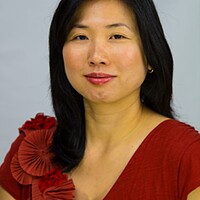Women in food: home cook, Keo Choulaphan
Loading...
When I first met Keo Choulaphan, I was instantly captivated by her elegant features and gentle demeanor. She looked stunning in traditional Lao dress–an elegant button-down pink blouse worn over an intricately-woven indigo and gold sarong-like skirt. A matching scarf was thrown gracefully over her shoulder.
It was a Sunday morning and I was waiting patiently at Our Lady of Mt. Virgin Church in Seattle, WA. The church deacon had promised to introduce me to some cooks in the community and he didn’t disappoint. Keo was one of them and she agreed to show me how to cook some traditional dishes from her native Laos. I later discover that Keo is Khmu, an ethnic group regarded as the indigenous inhabitants of northern Laos.
The following week, I visit Keo. She sports an apron that has clearly done much time in the kitchen and her wavy black hair is pulled back from her delicate face with a scarf. She is ready to cook.
In her small and simple kitchen, Keo is obviously queen. She bustles around the space confidently, chopping herbs with a machete-like knife and snapping a stalk of lemongrass in half to add to the soup bubbling on the stove.
As Keo whirls galangal, lime leaves, garlic, lemongrass, and chilies to make a seasoning paste for her Lao-style sausage, she tells me her days are pretty much routine. She goes to bed at 10 p.m. and wakes up at 5 a.m., she says. She soaks sticky (glutinous) rice in the morning and steams it in the evening. When she comes home from her childcare job, she cooks the evening’s meal – usually a soup, sausage, and perhaps some vegetables. On Sundays, she goes to church where she connects with other Lao community members.
On the other hand, Keo’s life back in Laos was far from routine. Her mother was sickly and at the tender age of 12, she was put in charge of cooking for the family and taking care of her brother. To help make ends meet, she learned how to make nam (sour fermented sausage) and the sausage she was now showing me how to make from a neighbor and sold it on the streets. Times have been tough for her but through sheer hard work and determination, Keo has survived on her own terms. “I do and I learn my own way,” she proclaims proudly.
Even now, Keo still makes a host of different foods such as sausages, beef jerky, spring rolls on the weekends to sell to friends and acquaintances. And she makes them the way she likes it. “If people don’t like it, I’ll eat it,” she says.
Keo may not have any formal education, but she more than makes up for it with resolve and resilience. Her strong character was obviously an attraction for her husband Bountha. “He came five times to my father to say he loved me,” relates Keo, not without a hint of glee. The fifth time was a charm and they got married in 1969 when Keo was 17. Although the marriage was arranged, Keo grew to love him dearly.
In the late 1970s, Keo and Bountha decided to flee post-communist Laos. To pave a safe passage for Keo and their then two children, Bountha wanted to set off first. Keo, who was three months pregnant, refused. She didn’t want to be left behind, nor did she want to face any uncertainty about his well-being. Keo told him simply, “I see you die. You see me die.”
Eventually, the family crossed the Mekong River together in a canoe and escaped to Thailand. They stayed in a refugee camp on the Thai-Lao border for 11 months where her second son was born. After the long wait, Keo and her family were finally given safe passage to the United States. She still remembers the exact day she arrived in Seattle. It was February 26, 1981.
Today, Keo has four surviving children and is grandmother to two beautiful little girls. She worries that her grandchildren are not learning the Khmu language and culture and tries to visit them as often as possible. Back home in Khmu villages, Khmu culture is traditionally passed down through evening story-telling sessions. As the next best thing, Keo hopes to record the many folktales that she holds as treasures in her head not just for her grandchildren but also future generations of Khmu children who might otherwise not know their culture.
A version of this profile was published in "The Asian Grandmothers Cookbook" (Sasquatch Books, 2009)








